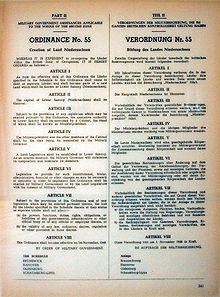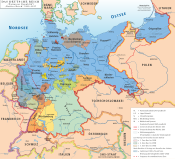Free State of Schaumburg-Lippe
| Free State of Schaumburg-Lippe Freistaat Schaumburg-Lippe (German) | |||||||||
|---|---|---|---|---|---|---|---|---|---|
| State of Germany | |||||||||
| 1918–1946 | |||||||||
 The Free State of Schaumburg-Lippe (red) within the Weimar Republic | |||||||||
 | |||||||||
| Capital | Bückeburg | ||||||||
| Area | |||||||||
• 1939 | 340 km2 (130 sq mi) | ||||||||
| Population | |||||||||
• 1939 | 53,277 | ||||||||
| Government | |||||||||
| • Type | Republic | ||||||||
| State Councillor | |||||||||
• 1918 (first) | Friedrich von Feilitzsch | ||||||||
• 1933–1945 | Karl Dreiera | ||||||||
• 1945–1946 (last) | Heinrich Drake | ||||||||
| Reichsstatthalter | |||||||||
• 1933–1945 | Alfred Meyer | ||||||||
| Historical era | Interwar · World War II | ||||||||
| 15 November 1918 | |||||||||
• Disestablished | 1 November 1946 | ||||||||
| |||||||||
| Today part of | Germany | ||||||||
| a. As State President. | |||||||||
The Free State of Schaumburg-Lippe (German: Freistaat Schaumburg-Lippe) was created following the abdication of Prince Adolf II of the Principality of Schaumburg-Lippe on 15 November 1918, following the German Revolution. It was a state in Germany during the Weimar Republic and Nazi Germany. The democratic government was suppressed during Nazi rule. At the end of the Second World War, the British military occupation government decreed on 1 November 1946 the union of Schaumburg-Lippe, Hannover, Braunschweig and Oldenburg to form the new state of Lower Saxony.


Government
[edit]The state parliament consisted of a Landtag of 15 members elected for a term of three years by universal suffrage. The state administration, headed by a Staatsrat (State Councillor), was responsible to the Landtag and could be removed by a vote of no confidence.[1] For most of the Weimar period, the state coalition governments usually were headed by a Social Democrat or a non-partisan technocrat.[2]
Following their seizure of power at the national level, the Nazi government embarked on a policy of Gleichschaltung (coordination) by which they intended to eliminate any potential sources of opposition in the states. On 8 March 1933, Reich Interior Minister Wilhelm Frick appointed Kurt Matthaei as the Nazi Reichskommissar to take direct control of police functions in Schaumburg-Lippe.[3] This provoked the resignation of the SPD-led coalition government.[2]
The Reich government next enacted the "Provisional Law on the Coordination of the States with the Reich" on 31 March 1933. This mandated that all the sitting state Landtage be dissolved and reconstituted on the basis of the recent 5 March Reichstag election results. By this means, the Nazi Party secured a working majority in the Schaumburg-Lippe Landtag and installed Hans-Joachim Riecke as the head of government on 1 April. On 7 April, the Reich government enacted the "Second Law on the Coordination of the States with the Reich" that established more direct control over the states by means of the new powerful position of Reichsstatthalter (Reich Governor). Alfred Meyer, the Nazi Party Gauleiter for Gau Westphalia-North, was installed in this new post for both Schaumburg-Lippe and Lippe on 16 May 1933.[4]
By the provisions of the "Law on the Reconstruction of the Reich" of 31 January 1934, all state Landtage were abolished and the sovereignty of the states was passed to the Reich government. With that, Schaumburg-Lippe effectively lost its rights as a federal state, though it continued to exist as an administrative unit of the Reich until the fall of the Nazi regime.
After the war, Schaumburg-Lippe was part of the British occupation zone. It lost its status as a separate German state when it was merged into the newly founded state of Lower Saxony on 1 November 1946, which subsequently became a part of West Germany upon its establishment in May 1949.
Government Leaders
[edit]| Name | Took office | Left office | Party | |
|---|---|---|---|---|
| Minister of State | ||||
| 1 | Friedrich von Feilitzsch | 15 November 1918 | 3 December 1918 | |
| Chairman of the State Council | ||||
| 2 | Heinrich Lorenz | 4 December 1918 | 14 March 1919 | SPD |
| State Councillors | ||||
| 3 | Otto Bömers | 14 March 1919 | 22 May 1922 | Ind. |
| 4 | Konrad Wippermann | 22 May 1922 | 28 May 1925 | Ind. |
| 5 | Erich Steinbrecher | 28 May 1925 | 7 October 1927 | SPD |
| – | Heinrich Lorenz | 7 October 1927 | 7 March 1933 | SPD |
| 6 | Hans-Joachim Riecke | 1 April 1933 | 23 May 1933 | NSDAP |
| Reichsstatthalter | ||||
| Alfred Meyer | 16 May 1933 | 11 April 1945 | NSDAP | |
| State President | ||||
| 7 | Karl Dreier | 25 May 1933 | 8 April 1945 | NSDAP |
| State Councillors | ||||
| 8 | Heinrich Bövers | May 1945 | 15 June 1945 | Ind. |
| 9 | Heinrich Drake | 15 June 1945 | 30 April 1946 | SPD |
| – | Heinrich Bövers | 30 April 1946 | 9 December 1946 | Ind. |
See also
[edit]References
[edit]- ^ "Der Freistaat Schaumburg-Lippe Überblick". Retrieved 2 March 2023.
- ^ a b "Der Freistaat Schaumburg-Lippe Die Landesregierungen 1918–1933". Retrieved 2 March 2023.
- ^ "Nazi Coup in States: Police Powers Seized". No. 46389. The Times (London). 10 March 1933. p. 14.
- ^ Miller, Michael D.; Schulz, Andreas (2017). Gauleiter: The Regional Leaders of the Nazi Party and Their Deputies, 1925–1945. Vol. 2 (Georg Joel - Dr. Bernhard Rust). R. James Bender Publishing. p. 292. ISBN 978-1-932-97032-6.
External links
[edit]



